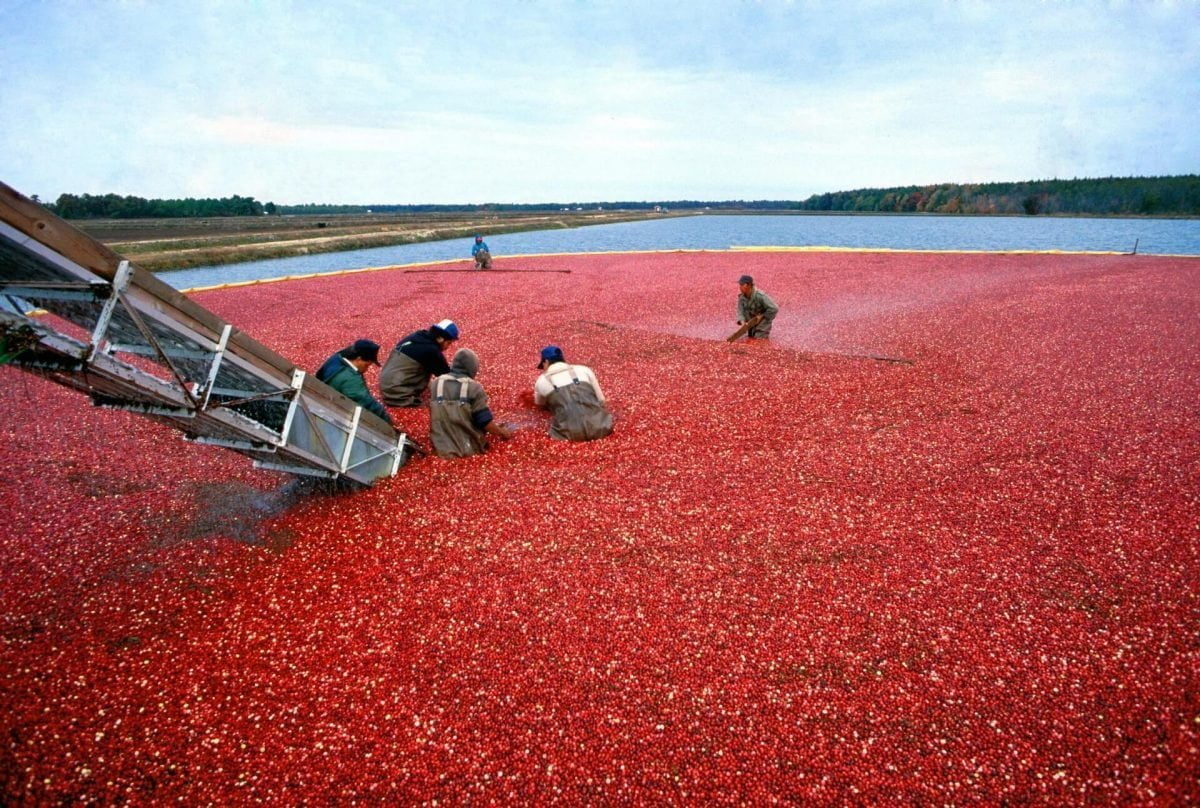
Share this post!
It’s that time of the year again. The magical season when the air becomes crisp and cool, leaves transform into brilliant hues of yellow, orange, and red, and many favorite fruits and vegetables are harvested, including the magnificent red delight known as the cranberry.
Cranberries are my favorite aspect of the Thanksgiving dinner spread. I love the sweet tartness of cranberry sauce and how it complements the savory turkey and trimmings. Whether you enjoy it canned (for nostalgia’s sake) or in a fresh chunky or jellied sauce, this seasonal fruit surely plays a role in at least one meal during the holidays.
Below I will share some interesting information about cranberry farming, nutrition, and recipes to take advantage of fresh cranberries this season.
Early Cranberry Cultivation
Cranberries are native to North America, growing wild in New England. History was made when a Revolutionary war veteran turned sea captain named Henry Hall noticed that the best producing cranberry vines near his home in Cape Cod were covered with sand blown from nearby dunes. Following these observations, he began optimizing growing conditions in the first cranberry cultivation effort in America in the early 1800s. His techniques quickly caught on and the number of cranberry growers grew quickly, spreading west to areas where wetland conditions and growing climate are ideal for cranberries. Today, the majority of cranberries are grown in only five states: Massachusetts, New Jersey, Wisconsin, Oregon, and Washington.
How Cranberries Are Grown
Despite common misconceptions, cranberries grow on vines, not bushes, and in marshy wetlands, though not under water, as the images of farmers wading through cranberry bogs would lead you to believe. In late spring, the vines produce a beautiful whitish pink flower that resembles a crane.
For this reason, or perhaps because cranes like to eat them, early European settlers referred to the berry as “craneberries”, which was eventually shortened to cranberries.
During the month of June, growers bring in 1-2 bee hives per acre to augment the native bee populations to pollinate cranberry blossoms. Following pollination, a green berry forms, changes to white and then to pink, and eventually deepens into a dark crimson when they are ready for harvest.
Harvesting occurs in late September through November via two methods: dry harvesting and wet harvesting. Only about 10% of cranberries are dry harvested. Farmers use “walk-behind” machinery to collect the berries into burlap sacks, which are typically hauled from the wetland by helicopter. Cranberries harvested by this method provide the fresh fruit found in markets and grocery stores from October to December.
The vast majority of cranberry crops are wet harvested, meaning that the fields are flooded the night before the harvest. Little pockets of air inside the cranberry give them the ability to float, which makes harvesting easier (and also makes for great pictures). Wet harvested cranberries are used for making juice, sauces, dried cranberries, nutraceuticals, and other processed foods.
The Importance of Water and Sand in Cranberry Cultivation
Water is not only important for typical plant hydration and harvesting; it also protects the vines from the cold. Modern cranberry farmers use sophisticated irrigation systems with sensors on the vines to monitor their temperature. In times of frost danger during the growing season, such as in spring or fall, the irrigation system will dispense a light covering of water over the vines to protect them. The small amount of water freezes, and by a physical property known as heat of fusion, the conversion of water to ice releases a small amount of heat that warms the plants. From December through March, farmers keep the dormant vines flooded to protect them from cold, wind, and pests.
Winter flooding also provides an opportunity to add a fresh layer of sand to the vines. Farmers spread a thin layer of sand over the ice every few years, which disperses sand evenly over the cranberry vines as it melts. Sand is a natural pest and weed management tool because it buries weed seeds, fungal spores, and insect eggs. In addition, the sand layer revitalizes the root structure and encourages the development of new shoots.
Cranberry Nutrition
Cranberries pack quite the nutritional punch into such a small berry. One cup of cranberries provides the following daily values:
- Vitamin C – 18%
- Manganese – 16%
- Fiber – 16%
- Vitamin E – 8%
- Copper – 7%
- Vitamin K – 6%
- Vitamin B5 – 6%
Cranberries also contain lots of flavonoids, including quercetin and proanthocyanidins (PACs), which contribute to the dark color of the berry. PACs are also thought to be the reason that cranberry products are effective in the treatment and prevention of UTIs. However, PACs are only a small fraction of the bioactive constituents of cranberries. New research shows that the complex carbohydrates in cranberries may also offer benefits to the urinary and gastrointestinal tracts.
Cranberry Complex Carbohydrates
Cranberries contain several types of oligosaccharides, which are a type of soluble fiber made from 3 to 20 sugar molecules bound together. They dissolve in water, yet the human body cannot digest them. The oligosaccharides of interest in cranberries are xyloglucans and pectins.
Xyloglucans are a type of hemicellulose, which is a part of the plant cell wall. Unlike cellulose, which is exclusively glucose molecules linked together in a straight chain, hemicellulose contains a variety of different sugars that are cross-linked. Hemicellulose is more soluble than cellulose, therefore it can be absorbed from foods into circulation and end up in the urinary tract to exert biological effects, for instance.
Pectins are another type of plant polysaccharide that contain galacturonic acid, which is derived from the sugar molecule galactose. Pectin is known for its ability to form a gel and is often used in making jams and jellies. It is present in sufficient quantities in cranberries to gelatinize them with only sugar and heat, which is why jellied cranberry recipes don’t call for any additional pectin or gelatin.
Biological Properties of Cranberry Oligosaccharides
Xyloglucans and pectins have many biological properties including:
- Bacterial anti-adhesion
- Potential mechanisms include interaction with bacterial adhesion receptors or cell surfaces and forming aggregates with pathogenic bacteria that prevent their adhesion to host cells.
- Effects on biofilm formation
- Though the mechanism is not well understood, the combination of flavonoids, including PACs, and oligosaccharides may prevent harmful bacteria from adhering and generating a biofilm that protects them and allows them to flourish, while promoting a favorable environment for symbiotic bacterial species to thrive.
- Growth responses
- Cranberry complex carbohydrates lack antimicrobial or cytotoxic effects to microbes, which benefits beneficial bacteria.
- Healthy stool
- Cranberry fibers form gels in the GI tract that absorb water to bulk up the stool and make it easy to pass.
- Affecting host health and immunity
- Oligosaccharides exhibit antidiabetic, anti-inflammatory, anti-oxidant, and anti-cancer properties.
- Prebiotic
- Soluble fibers can be fermented by good bacteria to generate short chain fatty acids (SCFAs) for energy, endothelial lining protection, and other benefits for host cells.
Oligosaccharides are truly exciting nutrients you should know about, and scientists are just beginning to identify and study them in cranberry research. Now let’s explore some culinary applications for fresh cranberries.

Fresh Cranberry Recipes
If you like experimenting with fermentation like I do, you should definitely give this lacto-fermented cranberry recipe a try. The following is an adaptation of this recipe from Grow Forage Cook Ferment:
- 12 oz. fresh cranberries
- Juice and zest of one orange (or other citrus fruit, such as lemon)
- 1” grated ginger
- 2 tbsp. honey (maple sugar or other sugars would work as well)
- 1 tbsp. whey (liquid from strained yogurt or kefir) – This may be omitted if not available or to make it vegan. Just double the salt and allow for longer fermentation time.
- ½ tsp non-iodized salt
- Spices – 1 cinnamon stick, a few cloves, black peppercorns, cardamom or any desired combination of these
- Filtered water as needed
Roughly chop or smash the cranberries. The berries should remain mostly whole, but you do want to rough them up a little bit to give the microbes access to the plant material to break down the starches.
Add berries to a quart size mason jar. Add citrus juice and zest, ginger, honey, whey, salt, and spices. Add water, leaving about 1” headspace. Cover and shake to incorporate ingredients. Place a weight on top of the berries to submerge them under your liquid. Lightly cover the jar and set aside for 5-7 days. Check for desired “readiness” by looking for bubbles and tasting for desired tartness.
Serving suggestions:
- Blend to make a fermented cranberry sauce
- Use as a topping for yogurt, oatmeal, or other breakfast grain
- Add to a mixed green salad with balsamic vinaigrette
- Try them in place of dried cranberries in this stuffed squash recipe
- With a savory poultry dish
Check out a few other NTI recipes that call for fresh cranberries:
A North American Treasure
Cranberries are a very special fall fruit with numerous nutritional benefits, including microbiome support from soluble fibers like xyloglucans and pectin. Personally, I am thankful for the culinary excitement and nutritional value that cranberries bring to the table during this time of year.
About the author:
Karyn Lane is a current student of NTI’s Nutrition Therapist Master Program. She finds her chemistry degree a useful tool in her study of nutrition and loves to treat herself as a laboratory for new recipes and cooking techniques. You can follow her on Instagram @feel.alive.nourishment.
Image:
Image by Joanna Kosinska is free for use by Unsplash
Image by Aaron Carlson is licensed under CC BY-SA 3.0
Image by Jean Beaufort is licensed under CC BY-SA 3.0
Image by Alyrat is free for use by Pixabay
Learn more about our school by attending an informational webinar.
Share this post!






















